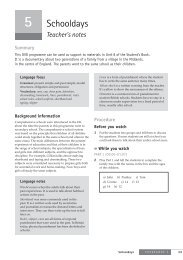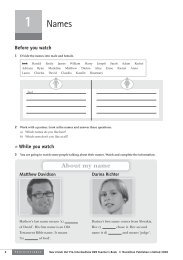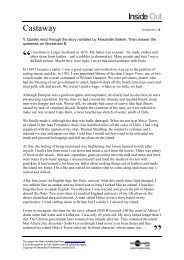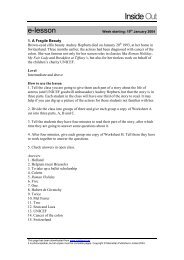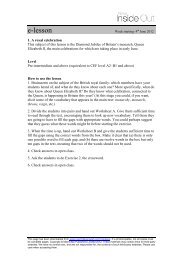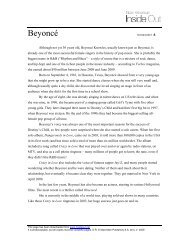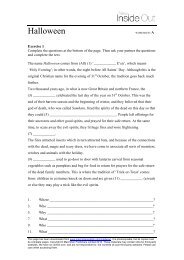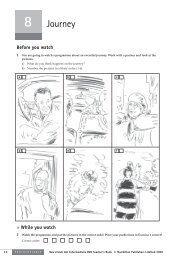e-lesson - Inside Out
e-lesson - Inside Out
e-lesson - Inside Out
You also want an ePaper? Increase the reach of your titles
YUMPU automatically turns print PDFs into web optimized ePapers that Google loves.
e-<strong>lesson</strong> Week starting: September 24, 2012<br />
1. Animals<br />
This week’s <strong>lesson</strong> contains interesting facts about different kinds of creatures – not just<br />
mammals, but also insects, birds, mollusks, and reptiles.<br />
Level<br />
Elementary and above (equivalent to CEF level A2 and above)<br />
How to use the <strong>lesson</strong><br />
1. Divide the class into two teams, Team A and Team B. If there are more than ten<br />
students in your class, divide them into four teams (two Team As and two Team Bs).<br />
2. Give each student in Team A a copy of Worksheet A, and each student in Team B a<br />
copy of Worksheet B. The teams should be as far away from each other as possible, so<br />
the other team(s) won’t hear their discussions.<br />
3. First, ask the teams to read the questions in Exercise 1 and match them with one of the<br />
answers underneath. Remind them not to let the other team(s) hear their answers. Note<br />
that there is one extra answer which will not be used. Explain that the word animal has<br />
been used throughout to apply to insects, reptiles, mammals, etc.<br />
4. Give teams a copy of their team’s answers only (not the other team’s!) from the next<br />
page and ask them to check their answers.<br />
5. Tell your students they are going to prepare a multiple-choice quiz for the other<br />
team(s). Refer them to Exercise 2, which shows an example of the question format. Ask<br />
them to do the same for all the questions. Encourage them to use their imagination and<br />
have fun inventing the answer options as well as the questions – they can use the<br />
information in any way they like and change the questions. If students know other<br />
interesting animal facts, they can create additional/alternative questions and answers as<br />
well – just make sure all teams create the same number of questions.<br />
6. If you have computer facilities, ask teams to type out their quizzes.<br />
7. Teams exchange their quizzes and work together to select the correct answer option for<br />
each question.<br />
8. Check answers in open class as a team game, with each team scoring one point for a<br />
correct answer. The team with the most points is the winner.<br />
This page has been downloaded from www.macmillanenglish.com/insideout. It is photocopiable, but all copies must be<br />
complete pages. Copyright © Macmillan Publishers Limited 2012. These materials may contain links for third-party<br />
websites. We have no control over, and are not responsible for, the contents of such third-party websites. Please use care<br />
when accessing them.
Answers:<br />
Exercise 1<br />
_ _ _ _ _ _ _ _ _ _ _ _ _ _ _ _ _ _ _ _ _ _ _ _ _ _ _ _ _ _ _ __ _ _ _ _ _ _ _ _ _ _ _ _ _<br />
Team A<br />
1. h 2. f 3. c 4. i 5. e 6. g 7. b 8. a 9. j 10. d<br />
_ _ _ _ _ _ _ _ _ _ _ _ _ _ _ _ _ _ _ _ _ _ _ _ _ _ _ _ _ _ _ __ _ _ _ _ _ _ _ _ _ _ _ _ _<br />
Team B<br />
1. h 2. i 3. d 4. g 5. j 6. k 7. b 8. e 9. c 10. f<br />
_ _ _ _ _ _ _ _ _ _ _ _ _ _ _ _ _ _ _ _ _ _ _ _ _ _ _ _ _ _ _ __ _ _ _ _ _ _ _ _ _ _ _ _ _<br />
Exercise 2<br />
Teams’ own answers<br />
2. Related websites<br />
Send your students to these websites, or just take a look yourself.<br />
http://animals.howstuffworks.com/animal-facts<br />
From Animal Planet, the website of the American satellite and cable television channel of<br />
the same name, some fascinating animal guides. The site is also packed with animal<br />
videos, games, pet guides, and wild animal facts. Challenging for Elementary level.<br />
http://www.corsinet.com/trivia/a-triv.html<br />
Interesting animal facts abound on this private trivia website, with lots of links to other<br />
interesting websites. Challenging for Elementary level.<br />
http://animals.nationalgeographic.com/animals/bugs/<br />
The “Bugs” section of the National Geographic “Animals” web pages. There are links<br />
along the top to the other sections: Amphibians, Birds, Fish, Invertebrates, Mammals,<br />
Prehistoric Animals, and Reptiles. With interesting facts and pictures. Accessible to<br />
Elementary level.<br />
This page has been downloaded from www.macmillanenglish.com/insideout. It is photocopiable, but all copies must be<br />
complete pages. Copyright © Macmillan Publishers Limited 2012. These materials may contain links for third-party<br />
websites. We have no control over, and are not responsible for, the contents of such third-party websites. Please use care<br />
when accessing them.



